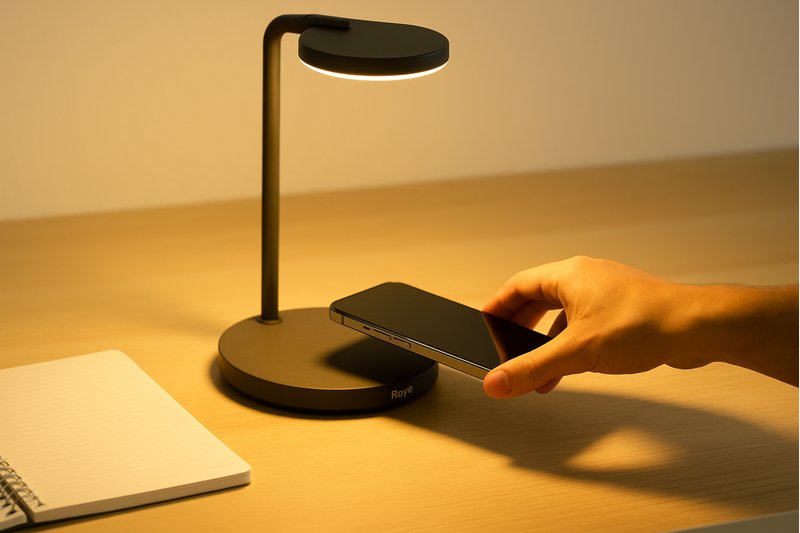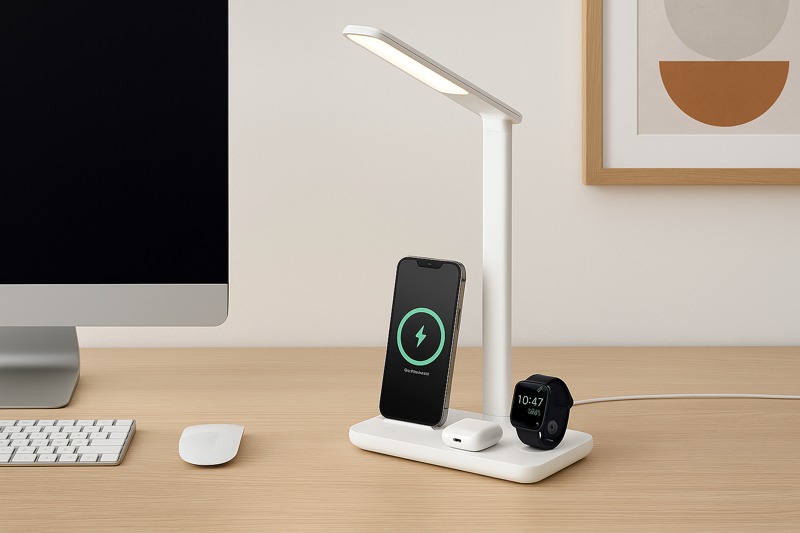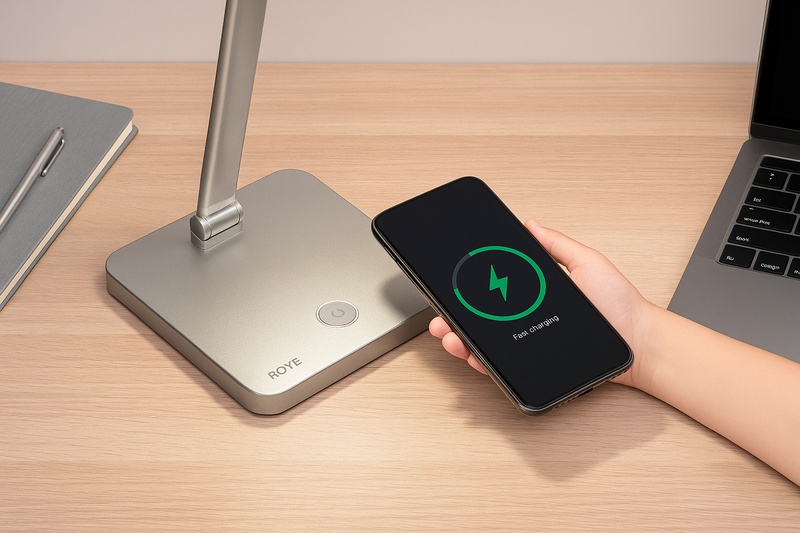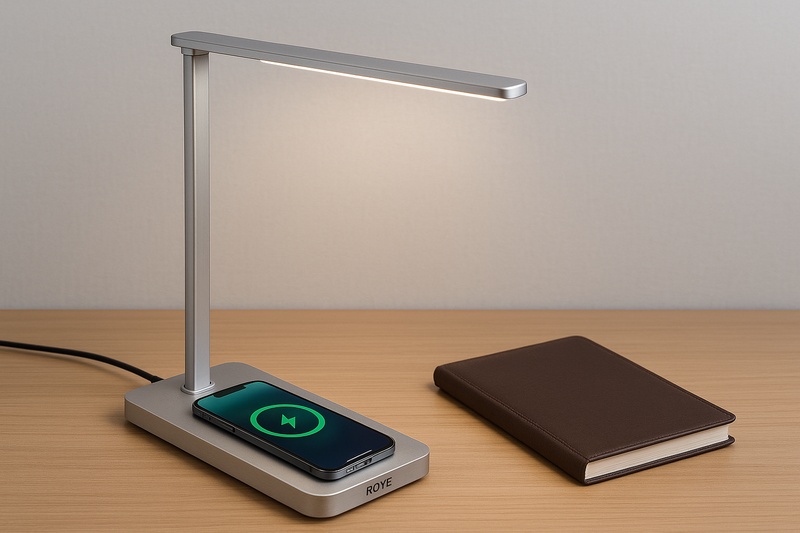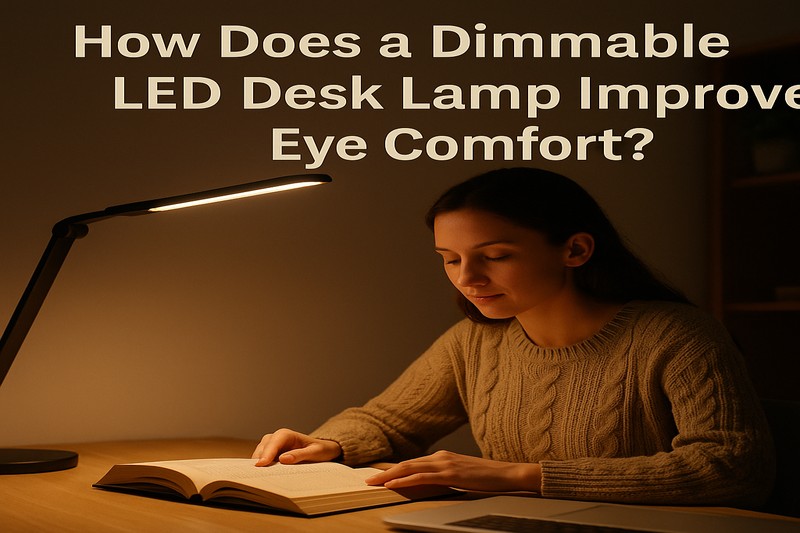
Tired eyes after a long day at your desk? Your lighting could be the problem.
Dimmable LED desk lamps reduce glare, match light to your task, and support healthier vision during long hours of work or study.
The solution to eye strain could be as simple as adjusting your lamp.
What Lighting Issues Cause Eye Discomfort?
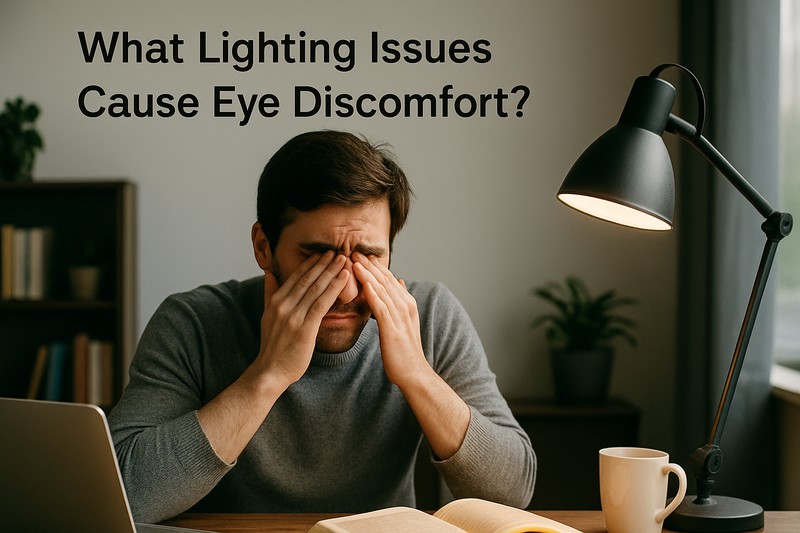
Flicker, glare, and poor lighting conditions can overwork the eye muscles.
Constant refocusing and brightness shifts lead to eye fatigue and vision-related headaches.
Understanding the Root Causes of Strain
When you're working at a desk for long periods, the lighting in your space becomes critical. Without proper illumination, your eyes constantly adjust between shadows and bright spots. This process, known as visual accommodation1, forces your eye muscles to contract repeatedly throughout the day.
One major culprit is flicker. Low-quality LED lamps often flicker2 imperceptibly due to unstable power delivery. Although you may not see the flicker, your brain does—and it processes these fluctuations as visual noise. Over time, this silent flicker contributes to eye strain, migraines, and focus issues.
Glare is another issue, caused by poor positioning or light bouncing off reflective surfaces. It reduces contrast on your work area, making it harder for your eyes to lock in on the text or object.
A dimmable LED desk lamp3 helps by offering stable, non-flickering illumination and reducing glare through soft diffusion. These adjustments make your work area visually consistent, easing the load on your visual system.
How Does Adjustable Brightness Support Eye Comfort?
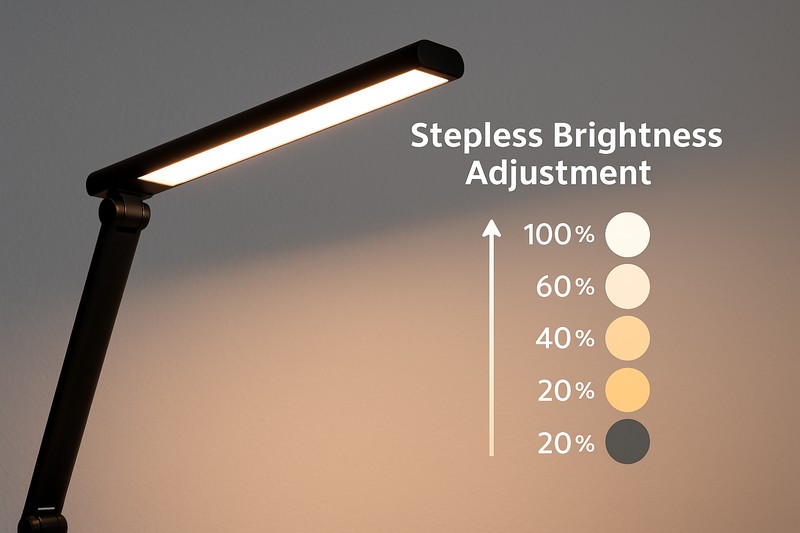
One level of brightness isn’t enough for every task or time of day.
Brightness control reduces overexposure and maintains consistent contrast, helping eyes stay relaxed.
Matching Light Intensity to Task and Environment
Whether you’re reading, drawing, typing, or attending Zoom meetings, each task needs a different amount of light. Brightness levels also depend on the time of day and the natural light in your room.
Dimmable LED lamps4 let you reduce light intensity in the evening or increase it when natural light fades. This protects your eyes from strain caused by working under lighting that is too dim or too harsh. For example, trying to read under insufficient lighting can cause your pupils to dilate excessively, which overworks the ciliary muscles of your eyes. Similarly, excessive brightness causes glare and squinting.
With a dimmable lamp, you can smoothly control the lighting level to fit your exact needs. The best lamps offer stepless dimming5 or multiple brightness presets so you’re not stuck with just “low,” “medium,” or “high.”
Many models also include memory settings that recall your preferred brightness when turned back on—eliminating the need to reset each time.
| Activity | Recommended Brightness (Lumens)6 | Purpose |
|---|---|---|
| Screen Use | 300–400 | Prevent screen contrast issues |
| Writing/Reading | 500–600 | Boost clarity without glare |
| Drawing | 700+ | Precision and visual detail |
Why Is Color Temperature Important for Vision?
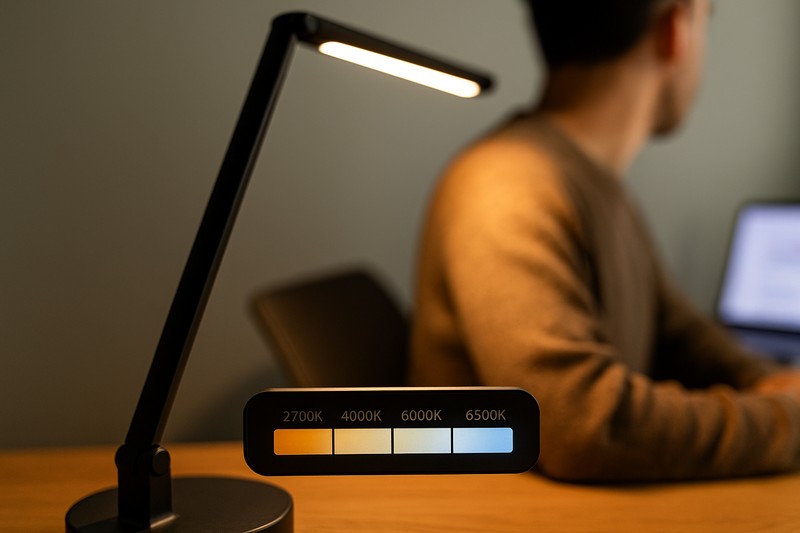
Lighting tone influences how your eyes respond over time.
Cool light improves alertness, while warm tones soothe eyes during night work.
Syncing Color with Human Biology
Color temperature refers to the hue of your lamp’s light, measured in Kelvins (K). Higher color temperatures (5000K–6500K) appear bluish-white and mimic daylight, which helps keep your mind focused and awake. Lower temperatures (2700K–3500K) create a yellowish, warm tone that reduces alertness and prepares your body for rest.
Using a bright white light while working in the evening may interfere with melatonin production and disturb your sleep cycle. Your eyes may also experience more fatigue under sustained exposure to cool lighting when it's no longer appropriate for the circadian rhythm.
Dimmable LED lamps with adjustable color temperature allow you to change this tone throughout the day. In the morning, choose a daylight setting to energize your workspace. As evening approaches, switch to a warm setting to wind down.
This dynamic adjustment helps reduce eye strain by ensuring your lighting works with—not against—your internal clock. Some lamps also include a “Night Mode” that automatically shifts the temperature down after a certain hour.
| Time of Day | Ideal Color Temperature | Why It Helps |
|---|---|---|
| Morning | 5000K–6000K | Boost focus and energy |
| Midday | 4000K–5000K | Neutral comfort zone |
| Evening | 2700K–3500K | Prepares for restful sleep |
How Do Flicker-Free and Anti-Glare Features Reduce Fatigue?

Invisible flicker and uneven lighting overstimulate your visual system.
Modern LED lamps use stable drivers and diffusers to create smooth, comfortable light.
Seeing the Unseen Causes of Fatigue
Flickering light, even when not visible to the naked eye, can cause eye discomfort over time. This issue arises from rapid fluctuations in current, especially in cheap LED products. These micro-flickers stimulate your retinal cells and visual cortex excessively, which leads to eye fatigue and concentration problems.
Another challenge is glare, often caused by uncovered bulbs or shiny desk surfaces. Glare causes visual discomfort by reducing the contrast ratio between your work material and the surrounding area. Your pupils constantly dilate and contract, making it harder to focus on your work.
High-quality dimmable LED desk lamps address both problems. They use flicker-free drivers, often based on constant-current technology, to deliver a stable light output. Many also feature matte or frosted lamp covers to diffuse the light softly across your workspace.
Better lamps also offer rotating heads and flexible positioning. This allows you to direct the light away from reflective surfaces and screens, further reducing glare. These seemingly small features make a big difference in long-term visual comfort.
What Ergonomic Features Support Eye Comfort Further?

Fixed lighting angles lead to awkward postures and visual tension.
A flexible lamp with rotating joints and stable arms helps reduce head movement and improve visual targeting.
Dive Deeper: Positioning Light Where It Matters
Your eyes don’t work in isolation—they follow your body’s alignment and task posture. If your lamp is fixed too high, too far, or aimed in the wrong direction, your neck and shoulders overcompensate. That misalignment often leads to dry eyes, eye strain, and even headaches from squinting or tilting your head.
An ergonomic dimmable LED lamp solves this by offering freedom of movement. Gooseneck designs, swing arms, and rotating heads let you direct light exactly where you need it, whether it’s on a notebook or a keyboard. This reduces the need to strain or reposition your body unnaturally.
Some lamps also offer height adjustment or clamp-on designs, making them ideal for small workspaces or shared desks. By keeping your work surface evenly lit and properly angled, the lamp supports your natural viewing habits and reduces the visual effort needed.
In other words, ergonomics and eye comfort go hand in hand.
| Part | Ergonomic Function | Visual Benefit |
|---|---|---|
| Gooseneck Arm | 360° flexible movement | Aims light exactly where needed |
| Rotating Head | Tilt & swivel | Avoids direct glare and shadows |
| Adjustable Base | Height or clamp mount | Keeps lamp steady and centered |
How Does Better Lighting Improve Work Performance?
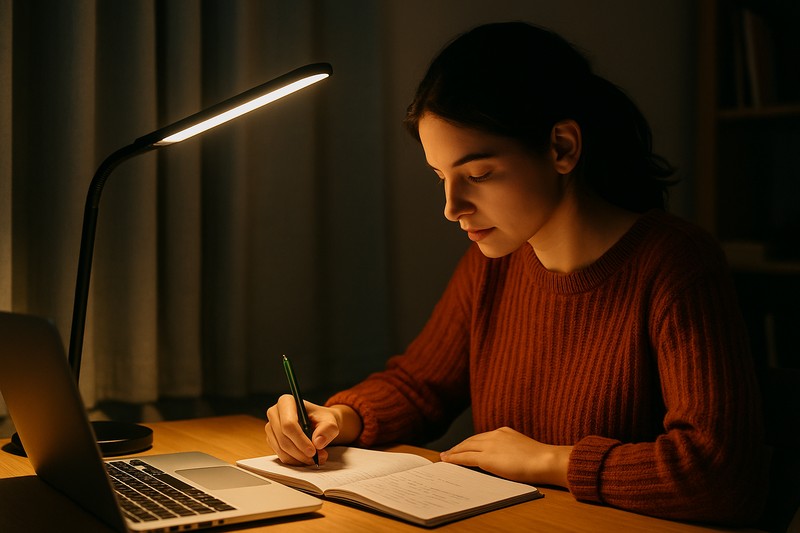
Comfortable eyes lead to better concentration and mental clarity.
With less strain, your brain processes information faster and more accurately.
Lighting's Role in Focus and Accuracy
Eye comfort and productivity are closely connected. When your eyes are stressed, your brain diverts resources to cope with that discomfort. This results in more frequent breaks, lower accuracy, and slower comprehension.
Proper lighting, like that from a dimmable LED desk lamp, reduces that cognitive load. You can sustain focus for longer, make fewer mistakes, and retain more information. This is especially important for students, designers, writers, and other knowledge workers who rely on visual clarity to perform complex tasks.
Studies show that office environments with personalized lighting controls lead to a 22% increase in task performance. In classrooms, better lighting reduces reading errors and improves attention spans.
In my own experience, using a warm-toned, dimmable lamp during evening writing sessions helped me avoid eye fatigue and stay productive. I no longer needed constant breaks or eye drops to keep going.
| Task Type | Benefit of Good Lighting |
|---|---|
| Studying | Improves retention and focus |
| Design/Art | Enhances visual accuracy |
| Reading/Writing | Minimizes distractions and fatigue |
Conclusion
A dimmable LED desk lamp customizes your lighting for visual comfort, helping you work longer, see clearer, and feel better.
-
Understanding visual accommodation can help you improve your workspace lighting and reduce eye strain. ↩
-
Learn about the impact of flicker on your vision and how to choose better lighting solutions. ↩
-
Discover how a dimmable LED desk lamp can enhance your workspace and protect your eyes. ↩
-
Explore the advantages of Dimmable LED lamps for eye comfort and lighting control in various activities. ↩
-
Learn about stepless dimming technology and how it enhances your lighting experience for different tasks. ↩
-
Discover the ideal brightness levels for various activities to optimize your lighting and reduce eye strain. ↩



